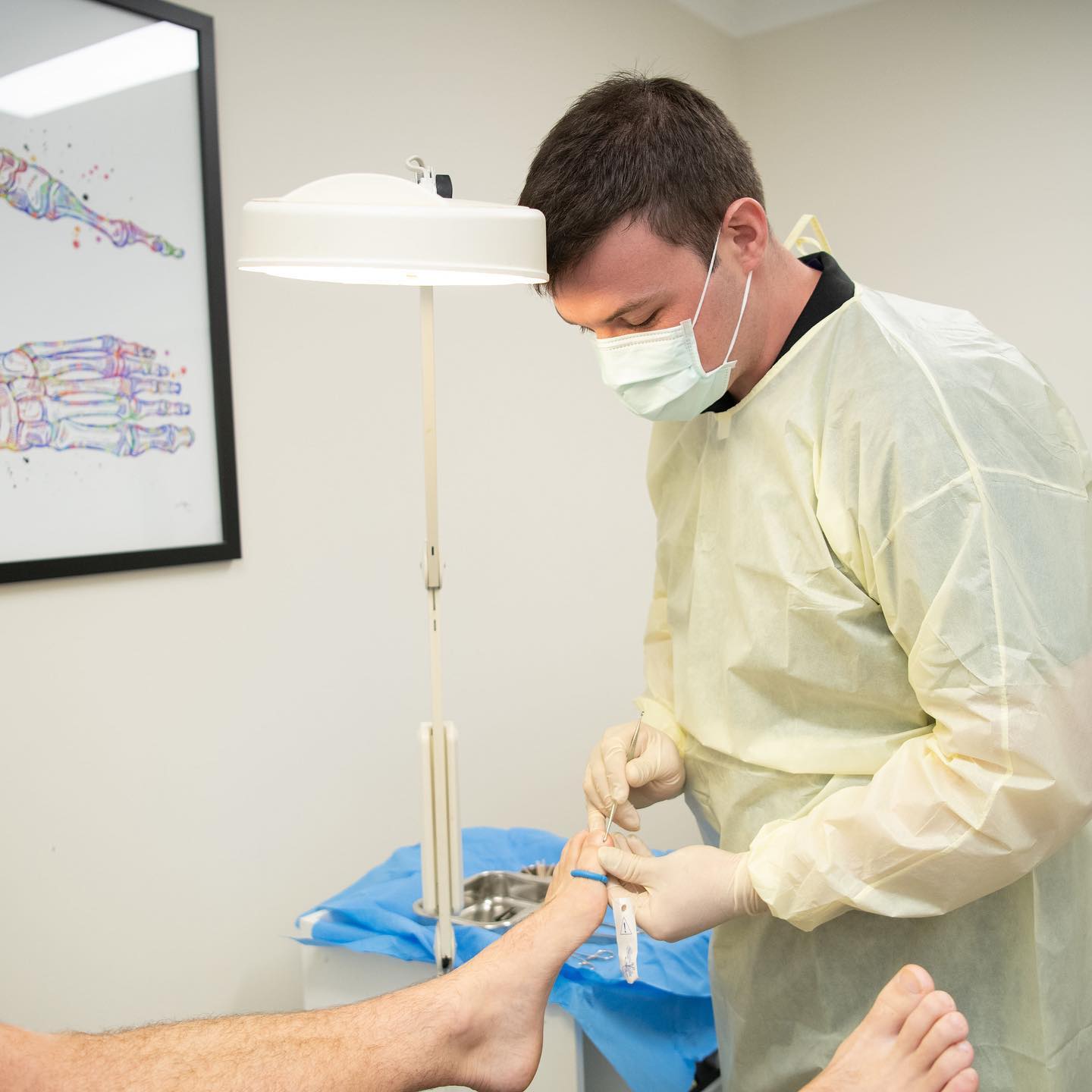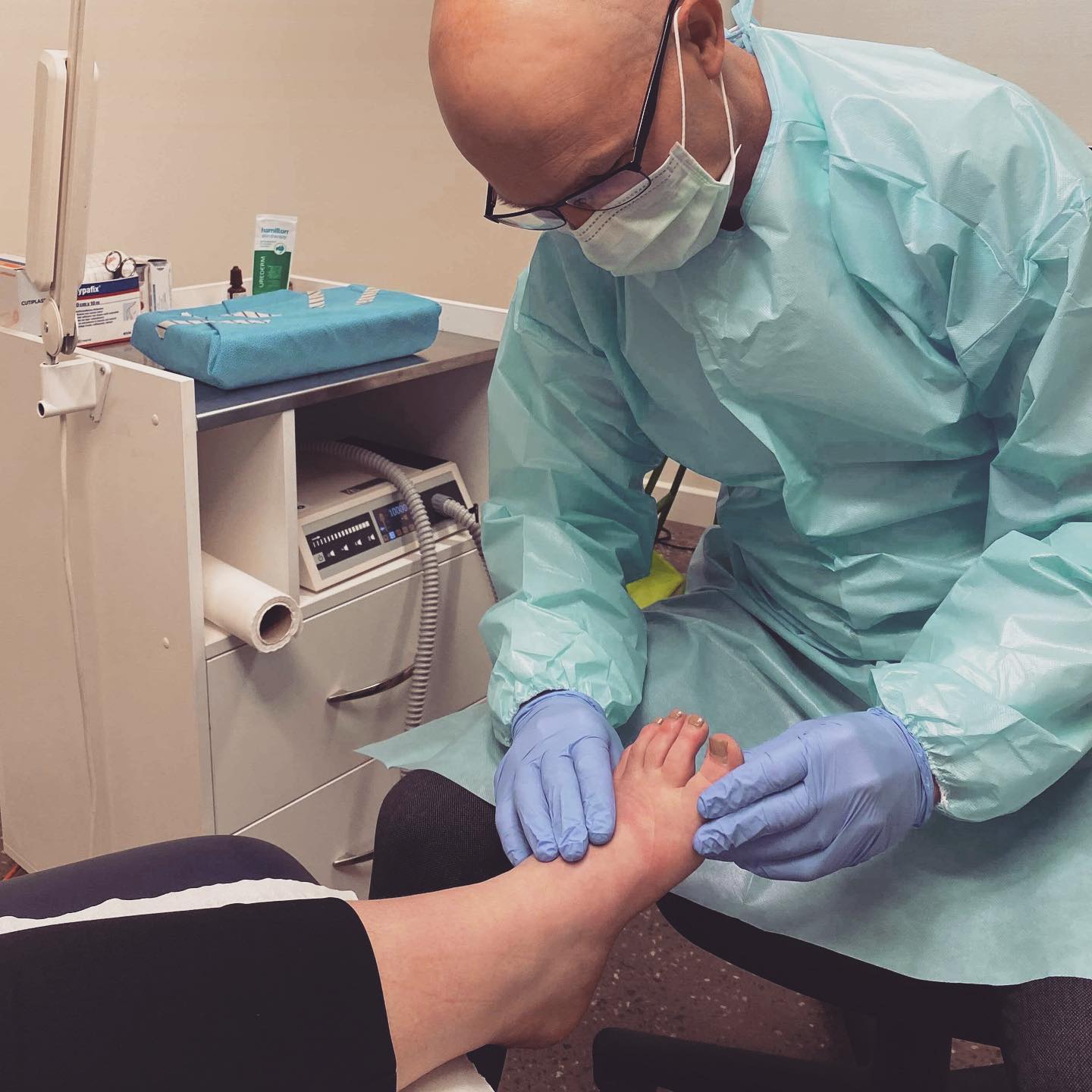Finding Relief from Foot and Ankle Pain – Your Guide to Choosing the Right Doctor
Foot and ankle pain can be a real headache. From making it difficult to walk around the house to stopping you from enjoying your favorite hobbies, it’s an issue that affects many people daily. In this blog post, we’re going to explore how you can take control of your pain by choosing the right doctor. You’ll get tips on identifying the causes of your discomfort, understanding when it’s time to seek help, and making an informed decision about which specialist to see.
Why Early Intervention is Key
Addressing foot and ankle pain early on is crucial for a number of reasons. First, early intervention can prevent the condition from worsening, mitigating the risk of more severe issues that could lead to long-term damage or chronic pain. Conditions like plantar fasciitis, Achilles tendinitis, or even simple sprains can escalate into more significant problems if not treated promptly. When pain is ignored, it often leads to compensatory movements and altered gait, which can cause additional stress on other parts of the body, such as the knees, hips, and lower back. This cascading effect can result in a cycle of pain that becomes increasingly difficult to manage over time.
Acting promptly by seeking medical advice ensures that you receive a proper diagnosis and an effective treatment plan before these secondary complications arise. Moreover, early detection and treatment often mean that you can take advantage of less invasive options, such as physical therapy, orthotic devices, or minor lifestyle changes, rather than resorting to surgery or long-term medication. Furthermore, early treatment tends to be more successful because the body is better able to heal from less severe injuries, giving you a better chance at a full recovery.
By addressing the issue head-on, you can return to your daily activities and hobbies without prolonged discomfort, thereby improving your overall quality of life. Whether you enjoy running, hiking, or simply taking a walk in the park, maintaining healthy feet and ankles is essential for staying active and mobile. Additionally, prompt treatment can also positively impact your mental health, as chronic pain is often linked to conditions like depression and anxiety. Therefore, taking immediate action not only helps your physical well-being but also supports your emotional and psychological health.

Foot and Ankle Pain
Identifying the Causes of Foot and Ankle Pain
Understanding the root cause of your foot and ankle pain is the first step towards effective treatment. There are numerous factors that can contribute to discomfort in these areas, making it essential to identify the specific issue you’re dealing with. Common causes include:
- Injuries: Sprains, strains, fractures, and dislocations can all lead to significant pain and require different treatment approaches.
- Overuse: Activities that place repetitive stress on the feet and ankles, such as running or dancing, can result in conditions like plantar fasciitis, Achilles tendinitis, and stress fractures.
- Arthritis: Osteoarthritis, rheumatoid arthritis, and gout are common culprits of joint pain in the feet and ankles, causing inflammation, stiffness, and discomfort.
- Biomechanical Issues: Problems such as flat feet, high arches, and improper gait can alter the way you walk and lead to pain and injuries over time.
- Ill-Fitting Footwear: Shoes that do not provide proper support or are too tight can contribute to foot problems, including bunions, hammertoes, and calluses.
- Medical Conditions: Diabetes, neuropathy, and circulatory issues can all lead to foot and ankle pain, often requiring specialized care.
By pinpointing the underlying cause of your discomfort, you can work with a healthcare professional to develop a targeted treatment plan that addresses your specific needs.
When to Seek Professional Help
Recognizing when to seek professional help for foot and ankle pain is crucial for preventing further complications and ensuring optimal recovery. If you experience any of the following symptoms, it’s advisable to consult a healthcare provider:
- Persistent Pain: Pain that lasts for more than a few days, especially if it doesn’t improve with rest or over-the-counter treatments, warrants a professional evaluation.
- Swelling and Bruising: Significant swelling, bruising, or changes in the appearance of your foot or ankle should be assessed by a medical professional to rule out fractures or severe injuries.
- Difficulty Walking: If you find it challenging to bear weight on your foot or ankle or if your gait has noticeably changed, seek medical advice to identify the underlying issue.
- Numbness or Tingling: These sensations can indicate nerve damage or compression, which may require specialized treatment to prevent long-term problems.
- Deformities: Visible deformities such as misalignment, protruding bones, or an abnormal shape of the foot or ankle are signs that you need professional intervention.
- Redness and Warmth: These symptoms, especially when accompanied by fever, can signal an infection or inflammatory condition that needs prompt medical attention.
Early consultation with a specialist can lead to an accurate diagnosis and effective treatment plan, helping you avoid prolonged discomfort and further complications. Whether it’s a podiatrist, orthopedist, or another healthcare provider, seeking professional help ensures that you receive the care you need to get back on your feet.
The Role of a Podiatrist
Podiatrists play a critical role in the diagnosis, treatment, and prevention of foot and ankle disorders. As specialists trained exclusively in foot and ankle care, podiatrists are equipped to address a wide range of issues, from common ailments to complex conditions. They perform thorough assessments to understand the underlying causes of pain and discomfort, utilizing diagnostic tools such as X-rays, MRI scans, and ultrasounds for accurate diagnosis.
One of the primary responsibilities of a podiatrist is to provide comprehensive treatment plans tailored to the individual needs of their patients. Treatments can range from conservative methods, such as orthotic devices, physical therapy, and medication, to more invasive procedures, including surgical interventions. Podiatrists are adept at handling everything from minor issues like bunions, corns, and ingrown toenails to more serious conditions such as plantar fasciitis, Achilles tendonitis, and congenital deformities.
Prevention is also a cornerstone of podiatric care. Podiatrists educate patients on proper foot hygiene, appropriate footwear, and exercises to strengthen the feet and ankles. For individuals with chronic conditions like diabetes, which can lead to severe foot complications, podiatrists provide crucial ongoing care to prevent ulcers, infections, and amputations.
Overall, podiatrists serve as invaluable members of the healthcare team, dedicated to ensuring the health and functionality of their patients’ feet and ankles. Their specialized expertise not only alleviates pain and treats existing conditions but also focuses on preventing future problems, thus enhancing the overall quality of life for their patients.

Foot and Ankle Pain
What to Look for in a Foot and Ankle Doctor
Finding the right foot and ankle doctor is crucial for receiving appropriate care and achieving the best possible outcomes. Here are several key factors to consider when choosing a healthcare provider for your foot and ankle needs:
- Credentials and Specialization: Ensure the doctor is board-certified and specializes in foot and ankle care. Board certification indicates that the doctor has undergone rigorous training and meets the high standards set by the medical board. Specialization is particularly important for complex conditions or surgical needs.
- Experience: Look for a doctor with substantial experience in treating foot and ankle issues. Experienced practitioners are likely to have encountered a wide range of conditions and can provide insightful and effective treatment plans.
- Reputation: Seek recommendations from family, friends, or your primary care physician. Additionally, online reviews and testimonials can provide insight into the doctor’s reputation, patient satisfaction, and the quality of care provided.
- Communication Skills: A good doctor should listen to your concerns, answer your questions clearly, and explain your diagnosis and treatment options in understandable terms. Effective communication fosters a trusting patient-doctor relationship and ensures you are well-informed about your care.
- Technology and Techniques: Inquire whether the doctor uses the latest diagnostic tools and treatment techniques. Advanced technologies and innovative treatment methods can lead to more accurate diagnoses, less invasive treatments, and quicker recoveries.
- Patient-Centered Approach: Find a doctor who emphasizes personalized care and develops tailored treatment plans based on your specific needs and lifestyle. A patient-centered approach ensures that your care plan aligns with your health goals and preferences.
- Convenience and Accessibility: Consider the location of the doctor’s office, availability of appointments, and the office hours. A conveniently located practice with flexible scheduling can make it easier to attend appointments and stay committed to your treatment plan.
- Insurance and Payment Options: Verify that the doctor accepts your insurance plan or offers reasonable payment options. Understanding the costs involved and whether they are covered by your insurance can help you manage your healthcare expenses.
By taking these factors into account, you can choose a foot and ankle doctor who meets your needs and provides high-quality, personalized care. Making an informed decision will help you get the support and treatment necessary to maintain healthy, pain-free feet and ankles.
Types of Treatments Available
When dealing with foot and ankle issues, a variety of treatments are available to address different conditions and severities. These treatments range from non-invasive methods to surgical interventions, depending on the diagnosis and individual patient needs.
Non-Invasive Treatments
- Orthotic Devices: Custom-made shoe inserts or braces that provide support, correct imbalances, and alleviate pain.
- Physical Therapy: Exercises and stretches designed to strengthen muscles, improve mobility, and aid in recovery.
- Medication: Pain relievers, anti-inflammatory drugs, and corticosteroids to manage pain and reduce inflammation.
- Laser Therapy: A non-invasive treatment that uses light energy to stimulate healing and relieve pain.
- Extracorporeal Shockwave Therapy (ESWT): A treatment that uses sound waves to promote healing of chronic conditions like plantar fasciitis.
Minimally Invasive Procedures
- Injections: Steroid injections to reduce inflammation and pain, or hyaluronic acid injections to lubricate joints.
- Cryotherapy: Freezing therapy to treat conditions like warts and certain types of skin lesions.
- Minor Surgical Procedures: Techniques such as ingrown toenail removal or bunion correction performed with minimal tissue disruption.
Surgical Treatments
- Bunion Surgery (Bunionectomy): Removal of bunions and realignment of the toe joint.
- Heel Spur Surgery: Removal of bony outgrowths on the heel that cause pain.
- Achilles Tendon Repair: Surgical correction of torn or damaged Achilles tendons.
- Arthroscopic Surgery: A minimally invasive surgical technique used to diagnose and treat joint problems, such as arthritis in the ankle.
- Reconstruction Surgery: Procedures to correct deformities, repair ligament tears, or replace damaged joints in severe cases.
Preventive and Supportive Care
- Custom Footwear: Specialized shoes designed to accommodate deformities, provide support, and prevent further issues.
- Diabetic Foot Care: Regular check-ups, specialized treatments, and guidance to prevent ulcers and infections in diabetic patients.
- Education and Lifestyle Modifications: Advice on proper foot hygiene, suitable footwear, and exercises to maintain healthy feet and ankles.
By exploring these various treatment options with a qualified foot and ankle doctor, patients can find effective ways to alleviate pain, improve mobility, and enhance their overall quality of life.

Foot and Ankle Pain
Importance of Communication with Your Doctor
Effective communication with your foot and ankle doctor is crucial for several reasons. It ensures that you fully understand your diagnosis and treatment options, allowing you to make informed decisions about your care. When you communicate openly and honestly with your doctor, it helps them to better understand your symptoms, lifestyle, and any concerns you may have. This information is vital for developing a personalized treatment plan that addresses your specific needs.
Moreover, good communication fosters a strong patient-doctor relationship built on trust and respect. When you feel comfortable discussing your health with your doctor, you are more likely to adhere to treatment recommendations and follow through with necessary lifestyle changes. This collaboration can lead to better health outcomes and a more positive healthcare experience.
If you have any questions or uncertainties, do not hesitate to ask your doctor for clarification. Your doctor’s role is to ensure you are well-informed and confident in managing your foot and ankle health. Regular check-ins and updates can also help to monitor progress and make any necessary adjustments to your treatment plan. In essence, maintaining open lines of communication with your doctor is a fundamental aspect of effective healthcare and can significantly contribute to your overall well-being.
Conclusion
Choosing the right foot and ankle doctor is crucial for managing any issues or concerns you may have with your feet and ankles. By considering factors such as their approach, convenience, insurance coverage, and available treatments, you can find a doctor who meets your needs and provides high-quality care. Additionally, understanding the different types of treatments available and the importance of communication with your doctor can further support your journey towards healthy feet and ankles. Be proactive in caring for your foot and ankle health by finding a qualified doctor whom you trust to guide you on this path.
Flagstaff Foot Doctors: Anthony Rosales DPM
https://www.google.com/maps?cid=8835841318590452161
421 N Humphreys St, Flagstaff, AZ 86001, United States
(928) 774-4825
https://flagstafffootandankle.com/
